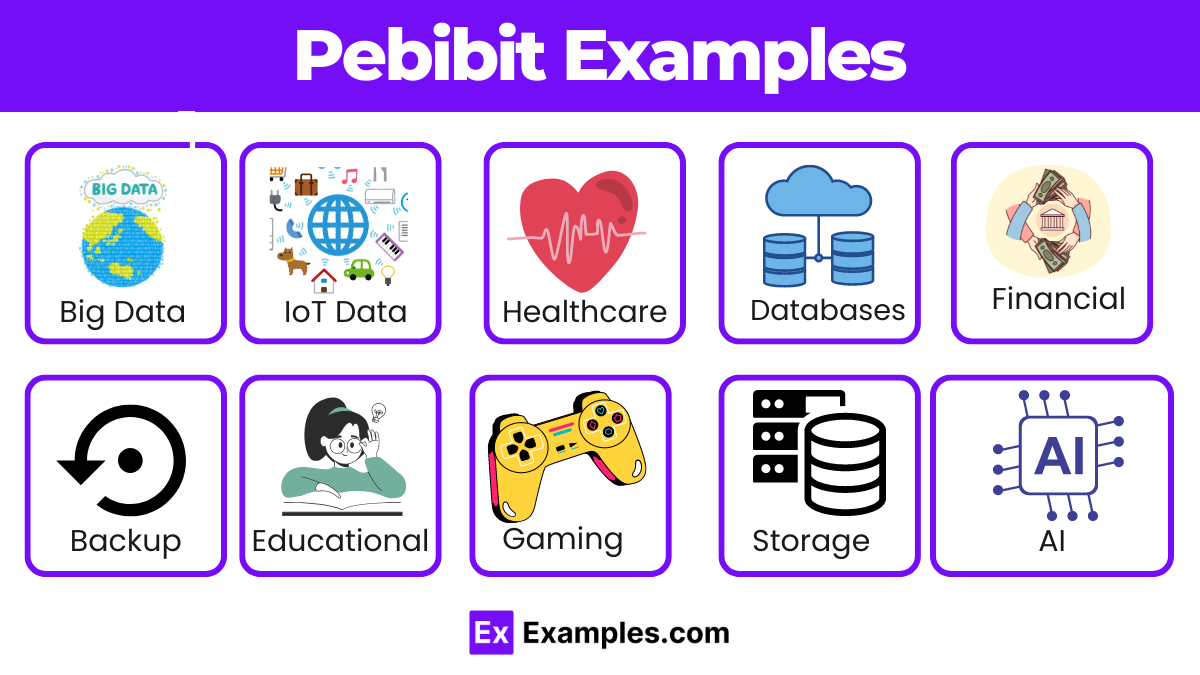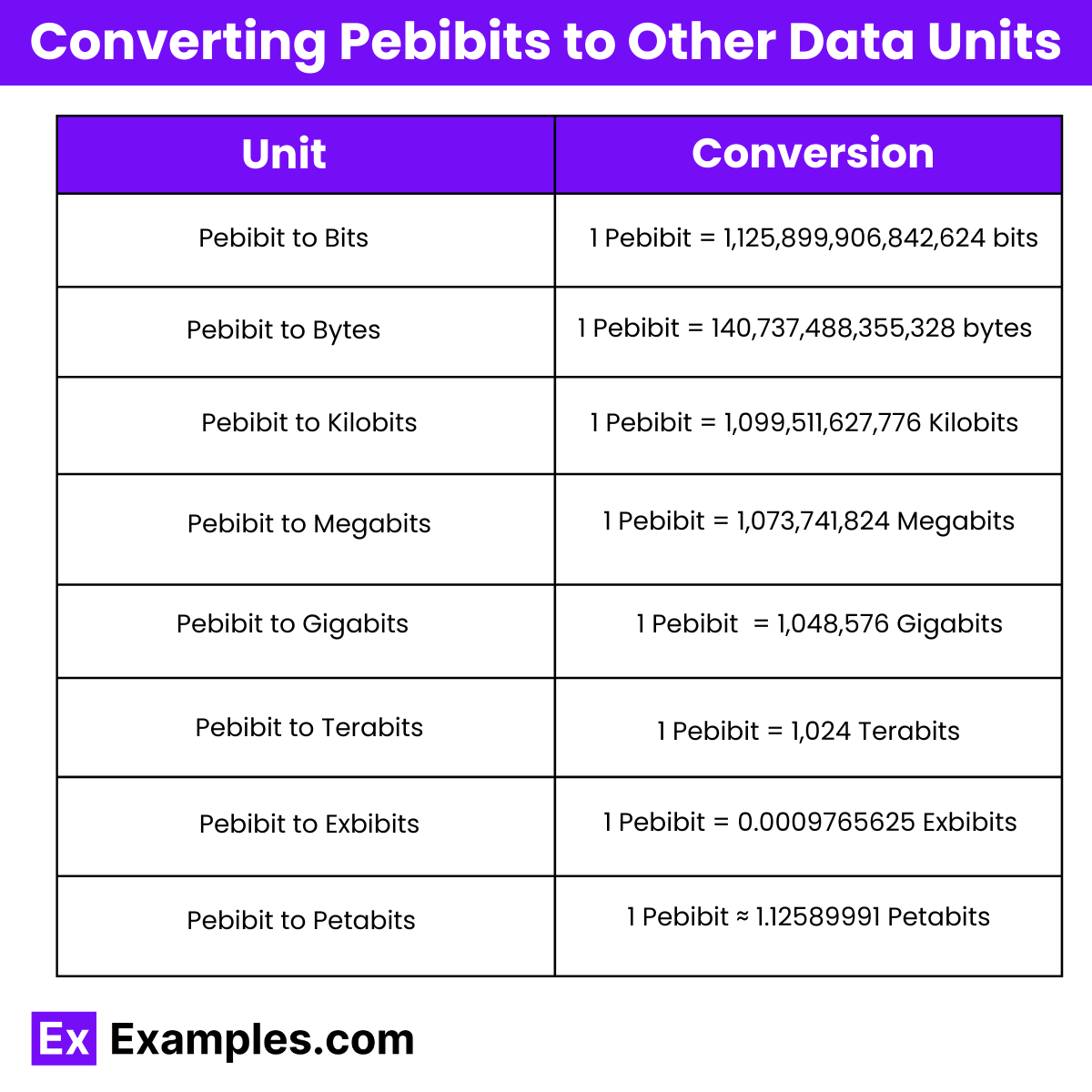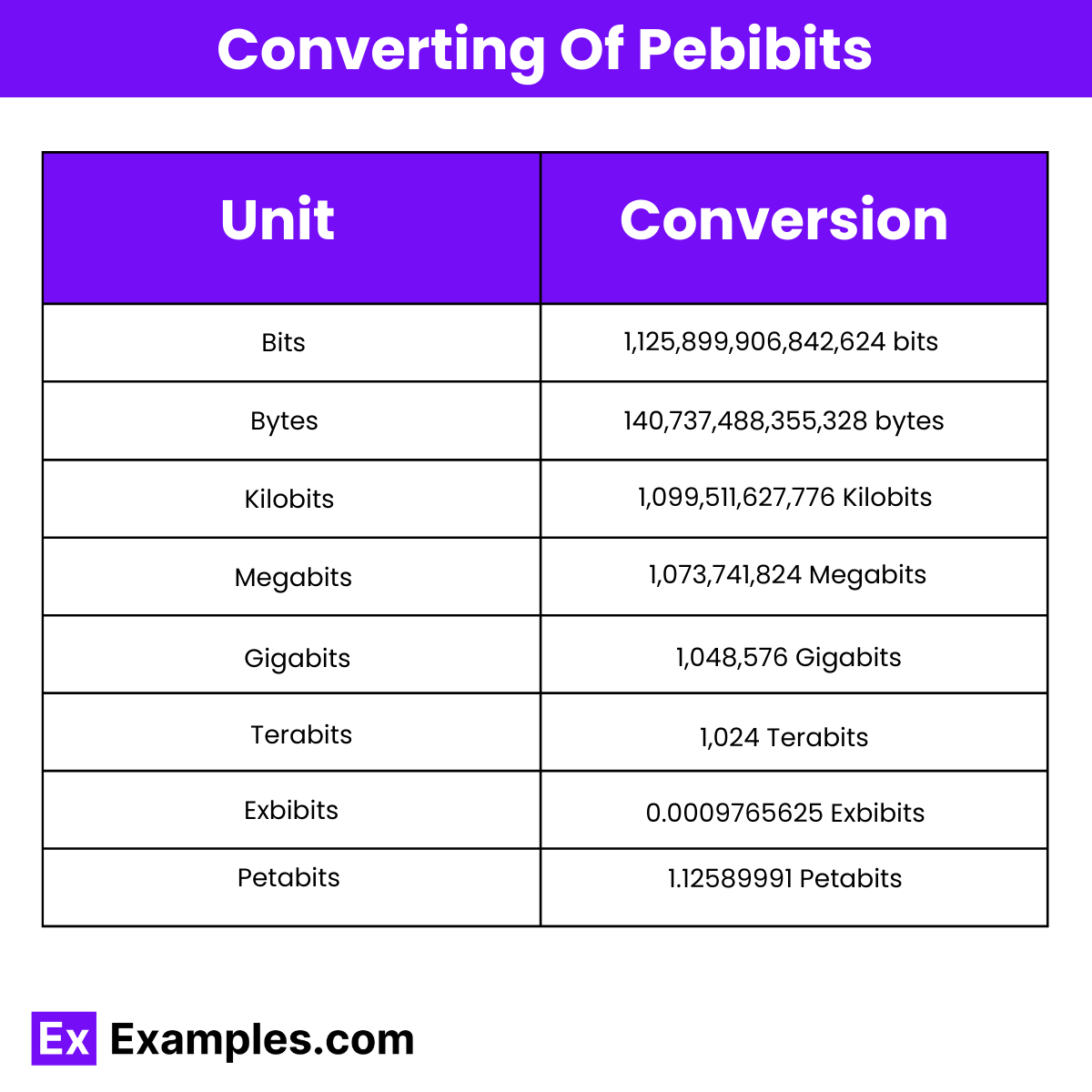Pebibit – 18+ Examples, Trends, Importance, Difference
A pebibit is a unit of digital information used primarily in computing and data storage. It represents 2⁵⁰ bits, equivalent to 1,125,899,906,842,624 bits. This vast capacity is essential for managing extensive datasets in fields like cloud storage, data centers, and large-scale computations. When dealing with data transfer speeds, it’s important to understand conversions and units like foot per second, meter per second, and miles per second, which are crucial for measuring the velocity of data transfer over a given period, typically a second. These measurements ensure accurate and efficient handling of data, making pebibits a critical unit for professionals managing significant data volumes and requiring precise data transfer metrics.
What is Pebibit?
A pebibit is a unit of digital information storage, equivalent to 2⁵⁰ bits or 1,125,899,906,842,624 bits. Unlike units of length or time, such as meters or seconds, a pebibit measures data capacity. It is part of the binary system used in computing, where data is quantified in bits. The term is derived from combining “peta,” indicating the factor of 2^50, and “bit,” the basic unit of digital information. Pebibits are commonly used to describe large data storage or memory capacities.
Pebibit Examples

- Large Databases – Corporate data warehouses storing extensive customer information and transaction histories.
- Cloud Storage – Providers like AWS, Google Cloud, and Microsoft Azure offering large-scale storage solutions.
- Big Data Platforms – Systems like Hadoop and Spark processing massive datasets for analytics.
- Scientific Research Data – Large-scale genomics projects storing DNA sequencing data.
- High-Resolution Video Storage – Streaming services like Netflix storing 4K and 8K video content.
- Backup Systems – Enterprises using extensive backup solutions to ensure data integrity and recovery.
- AI and Machine Learning – Training datasets for deep learning models requiring large storage capacities.
- IoT Data Management – Smart cities storing vast amounts of data from sensors and connected devices.
- Financial Institutions – Banks and trading platforms storing transaction data and financial records.
- Government Archives – National archives storing extensive historical and administrative records.
- Telecommunications – Companies managing data from network traffic and communication logs.
- Healthcare Systems – Hospitals storing large volumes of patient records, imaging data, and research data.
- Educational Institutions – Universities storing research data and academic resources.
- Virtual Reality Content – Companies creating and storing high-resolution virtual reality experiences.
- Gaming Industry – Game developers storing detailed graphics, textures, and game world data.
- E-commerce Platforms – Online retailers storing product information, customer data, and transaction histories.
- Social Media Platforms – Companies like Facebook and Twitter managing extensive user-generated content.
- Media and Entertainment – Studios storing digital assets, including high-definition movies and soundtracks.
Pebibit Storage
- Introduction to Pebibits: Understanding the Unit – A pebibit equals 2⁵⁰ bits, used for large data storage.
- Pebibit vs. Petabit: Key Differences – Pebibit uses binary system (2⁵⁰ bits), while petabit uses decimal system (10¹⁵ bits).
- Applications of Pebibits in Data Storage – Essential for storing vast amounts of data in servers, data centers, and cloud storage.
- Converting Pebibits to Other Data Units – 1 Pebibit equals 1,024 Tebibits or 1,125,899,906,842,624 bits.
- The Importance of Pebibits in Modern Computing – Crucial for managing and storing large-scale data in modern technology infrastructure.
- Pebibit Measurement in Digital Information Systems – Pebibits measure large data capacities in digital and computing systems.
- Storing Large Data Sets: The Role of Pebibits – Ideal for storing extensive databases, high-resolution videos, and large-scale scientific data.
- Future Trends: The Growing Need for Pebibits – Increasing data generation drives the demand for larger storage units like pebibits.
Future Trends The Growing Need for Pebibits
- Big Data Analytics – Advanced analytics require massive data storage for collecting and analyzing extensive datasets.
- Cloud Storage Expansion – The rise in cloud-based services demands scalable storage solutions.
- High-Resolution Media – 4K/8K videos and high-definition content need substantial storage capacities.
- Internet of Things (IoT) – Billions of connected devices generate vast amounts of data needing efficient storage.
- Artificial Intelligence – AI and machine learning applications require extensive data storage for training models.
- Scientific Research – Large-scale scientific projects produce enormous datasets, necessitating high-capacity storage.
- Data Backup and Recovery – Enhanced backup solutions for data security and disaster recovery increase storage requirements.
- Business Data Growth – Enterprises generate and store massive amounts of data for operations, requiring large storage solutions.
Importance of Pebibits in Modern Computing
- Data-Intensive Applications – Essential for applications that handle large datasets, such as big data analytics and data warehousing.
- Cloud Computing – Vital for cloud storage solutions, allowing for scalable and efficient storage of vast amounts of data.
- High-Performance Computing (HPC) – Supports HPC environments, which require significant storage for simulations and complex computations.
- Digital Media Storage – Necessary for storing high-definition videos, images, and a files, especially in the entertainment industry.
- Scientific Research – Important for storing large datasets generated by scientific experiments and research projects.
- Backup and Recovery Solutions – Key for data backup and disaster recovery, ensuring data integrity and availability.
- Virtualization and Containerization – Supports virtualized environments and containerized applications by providing ample storage.
- Enterprise Data Management – Enables businesses to manage and store extensive operational data, improving efficiency and decision-making processes.
Applications of Pebibits in Data Storage
- Data Centers – Crucial for data centers managing extensive databases and cloud services.
- Scientific Research – Stores large datasets from experiments and simulations in fields like genomics and climate modeling.
- Media and Entertainment – Supports storage of high-resolution video content, such as 4K and 8K movies.
- Big Data Analytics – Handles massive datasets required for big data processing and analysis.
- Cloud Storage – Facilitates scalable storage solutions for cloud-based applications and services.
- Internet of Things (IoT) – Stores vast amounts of data generated by billions of connected devices.
- Artificial Intelligence – Provides the necessary storage for training and running AI and machine learning models.
- Enterprise Backup Solutions – Ensures data integrity and availability through comprehensive backup and recovery systems.
Converting Pebibits to Other Data Units


Pebibit vs. Petabit Key Differences
| Feature | Pebibit (Pib) | Petabit (Pb) |
|---|---|---|
| System | Binary (2^50 bits) | Decimal (10^15 bits) |
| Bit Equivalent | 1,125,899,906,842,624 bits | 1,000,000,000,000,000 bits |
| Bytes Equivalent | 140,737,488,355,328 bytes | 125,000,000,000,000 bytes |
| Usage | Common in computing and data storage | Common in telecommunications |
| Conversion to Bits | 1 Pib = 1,125,899,906,842,624 bits | 1 Pb = 1,000,000,000,000,000 bits |
| Prefix Meaning | “Pebi” indicates 2^50 | “Peta” indicates 10^15 |
| Data Units | Part of binary data measurement | Part of decimal data measurement |
| Applications | Used in data centers, large storage systems | Used in networking, internet data speeds |
Uses
- Data Centers – Managing extensive databases and cloud services.
- Cloud Storage – Scalable solutions for storing large volumes of data.
- Big Data Analytics – Handling massive datasets for analysis.
- High-Performance Computing – Supporting simulations and complex computations.
- Scientific Research – Storing large datasets from experiments and simulations.
- Media and Entertainment – Storing high-definition videos, images, and a files.
- Backup Solutions – Ensuring data integrity and availability through comprehensive backup systems.
- IoT Data Storage – Managing vast amounts of data generated by connected devices.
- AI and Machine Learning – Providing necessary storage for training and running models.
- Enterprise Data Management – Storing extensive operational data for business processes.
- Virtualization – Supporting virtualized environments with ample storage capacity.
- Streaming Services – Enabling large-scale video and a streaming platforms.
- Healthcare – Storing medical records, imaging data, and genomic information.
- Government and Military – Managing secure and extensive data repositories.
- Financial Services – Handling transactional data and large datasets for analysis.
- Education and Research Institutions – Supporting research projects and data-intensive studies.
- Telecommunications – Storing large volumes of communication data.
- Gaming Industry – Managing data for high-resolution games and virtual environments.
How does a Pebibit differ from a Petabit?
A Pebibit uses the binary system (2^50 bits), while a Petabit uses the decimal system (10^15 bits).
What is the primary use of Pebibits?
Pebibits are used for measuring large data capacities in computing and digital storage systems.
How many bits are in a Pebibit?
There are 1,125,899,906,842,624 bits in a Pebibit.
How many bytes are in a Pebibit?
There are 140,737,488,355,328 bytes in a Pebibit (since 1 byte = 8 bits).
How many Tebibits are in a Pebibit?
There are 1,024 Tebibits in a Pebibit.
What does the prefix ‘Pebi’ indicate?
The prefix ‘Pebi’ indicates a factor of 2^50 in the binary system.
Why is the Pebibit important in modern computing?
Pebibits are crucial for managing and storing large-scale data in data centers, cloud storage, and scientific research.
How do you convert Pebibits to Gigabits?
1 Pebibit is equal to 1,048,576 Gigabits (Gib).
Is a Pebibit larger than a Terabit?
Yes, a Pebibit is larger than a Terabit. 1 Pebibit equals 1,024 Terabits (Tib).
What are some common applications of Pebibits?
Applications include data centers, cloud storage, big data analytics, scientific research, and high-definition media storage.



